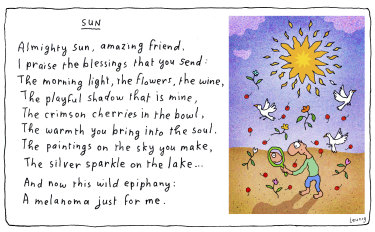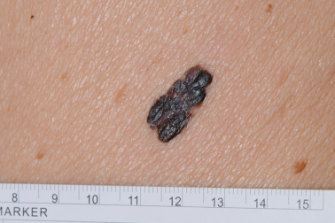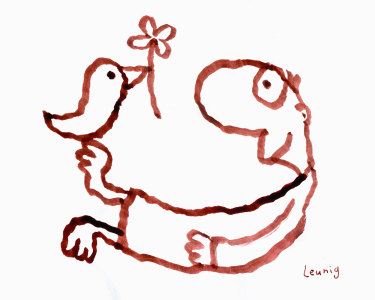It is said that before the age of 30 you have the face that God gives you, and after 30 you have the face that you give to yourself.
Through recent experience I can now advise that you may then get the face given to you by a plastic surgeon who is trying to repair the damage done by serious misfortune.
A melanoma moment.Credit:
And so it was, that instead of having my much-needed summer break, I received the diagnosis of an invasive melanoma on my face and found myself suddenly in an operating theatre with a plastic surgeon carving the life-threatening tumour out of my cheek.
A week-and-a-half later another procedure called a "skin flap restoration" was performed; a surgical rearrangement of facial skin – stretching and dragging the surface of my left cheek towards the nose, and so covering the wound created by the removal of the cancerous tumour.
I cannot quite grasp the elaborate tailoring of human tissue required for this: the various incisions and stitches needed to make my poor old face look presentable. Nor can I imagine the depth of training and skill required to do such bold and delicate work, restoring peace of mind and dignity to a traumatised and disfigured patient. And try as I might, I could not get a grip on the physical and emotional shock I was in.
A common type of melanoma.Credit:The Skin and Cancer Foundation Inc.
The small lump on my cheek was at first thought to be benign, but a phone call from a dermatologist as I was shopping for groceries announced that it was in fact a relatively rare and aggressive type of melanoma. I took the news calmly enough at first, but soon after felt a rush of extreme sadness for myself. “Ah, now this,” I thought, as I felt my life tip eerily sideways in the supermarket. Visions of suffering and death swirled into mind as the groceries filled my basket: rolled oats, coconut yoghurt, broccoli, lemons, bread; all good things.
Loneliness grew in the days thereafter. Grief about self is a sombre bedfellow, and indeed, my bed became a place of sorrow and alienation in the mornings and nights that followed. My history of pain began to drift before my eyes: the injuries, illnesses and misfortunes – the scars that I had worn with boyish pride; the wounds and broken bones, the heartaches, the horrible burns, the totally deaf ear, the almost blind eye, the near-fatal head trauma, the bombshell near miss with a lightning strike, the shock of the ghastly human corpses I had been confronted with over the years, the cattle I killed in the abattoirs as a young labourer, the blood and guts I cleaned up; all this and more – all the wear and tear of a physical life so deeply felt.
“You poor bastard,” I said to myself as it all came flooding back to me in a long moment of self-sorrow.
Early in my shock, the cancer began to feel like I had been hit by a sniper’s bullet, or bitten by a brown snake, with the venom creeping through my body; gloomy narrow thoughts of doom and victimhood, all infused with the sorrow of an imagined departure from this world.
The mental melodrama ran its lurid course and soon enough I started to understand that my cancer had not come only from the outer world, it had also come from within; it was mine and I would do well to own it. This idea seemed to help enormously because I reasoned that if I had a part in creating it, I might now be able to play a part in managing or healing it. This thought did not make me more hopeful, but it did illuminate a new creative project; a lively prospect which began to displace my rather helpless morbidity. I started to sense that a new liberating chapter of life could be under way, even if death was to be included.
The bird of healing.Credit:
It’s true: suffering is holy ground, and I imagine that’s partly because it is common ground. In the waiting rooms of the Peter MacCallum Cancer Centre in Melbourne they come from everywhere: the many human types, of all ages and all cultures – each one with cancer; some looking vulnerable and anxious, others with partners to sit beside them as they wait for their appointment numbers to appear on a large screen. I would sit waiting for my turn, feeling part of a congregation gathered in a common faith. There is no pretence here, no fashion, no nonsense … this is a frank and practical place, but there is something very humane in the air, something real, a quality rare and true and lovely if only you can feel it through the anxiety; a strong atmosphere of shared humility, sympathy and ordinary human warmth that is deeply touching. A strange surprising privilege it is to find in abundance the holy spirit of human suffering, cradled within this spectacular, curvaceous, light-filled building; sometimes called ‘the spaceship’ in tones of hopeful good humour.
The spaceship: inside the Peter MacCallum Cancer Centre in Melbourne.
Illness can be a very lonely time; particularly so when the affliction could be lethal. Every little smile or kindness that comes your way is uplifting; each good-humoured moment, every sweet meeting with another’s eyes, every visit from a friend who has come to just be with you and share plain words or easy silences for a while – these things are divine. And there are the neighbours, the ones you don’t know well; some appear at your door bearing simple good wishes and gifts of food. Saintliness … this is it! And then there are those surprising souls, the ones you thought were close, who pull away and seem indifferent. Not salt of the earth during these times of trouble, but salt in the wound; or so it seems to you.They have troubles of their own I guess, or they don’t know what to say. Dismay is a sharp and quiet little grief. Father forgive them. Forgive me. Forgive us all.
Frightful human suffering is normal and forever around us, and for me it seemed hellish in the weeks around Christmas. Yet the closer you come to death, the more you may come to life; warmed by the poignancy and gratitude it brings.
Out of those dark and troubled days, I can thankfully remember the inspiring care and company of nurses, the humane culture of a hospital and the touching dignity of ordinary suffering souls; all woven in my mind at the time with the enduring old story of the child in the manger. There was anguish, but there were nourishing revelations galore. And miraculously, there was Angela, the extraordinary plastic surgeon who gave me a new face which can certainly smile again as I now turn to the precious uncertain future.
Source: Read Full Article




